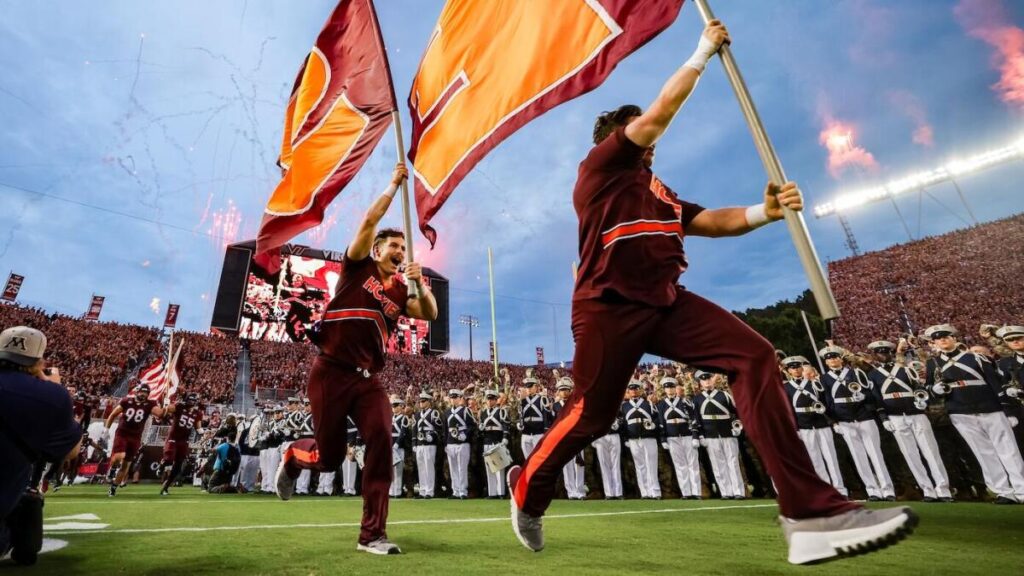Virginia Tech athletic director Whit Babcock posed the following question to the university’s board of visitors in an August presentation: “Where does the board aspire to be positioned — specifically with our investment levels in football?”
Put another way, Babcock was asking, as an institution, how much does Virginia Tech care about winning?
The question is even more pertinent one month later as Virginia Tech embarks on a coaching search to replace Brent Pry, who was fired Sunday amid an 0-3 start to his fourth season.
Sorting through Virginia Tech’s interest in Shane Beamer: Would South Carolina coach leave for alma mater?
Brad Crawford
If Virginia Tech can answer the question authoritatively and with institutional alignment in the weeks ahead, it has the chance to attract a coach who can restore the Hokies’ national relevance. The alternative is far more bleak.
Virginia Tech boasts a strong history, but that history was largely written under the tenure of one coach — Frank Beamer — in a bygone era of college athletics. It’s a new day in college sports. Cash is king more so than ever before and the Hokies have fallen behind in a way that will require corrective action if Pry’s successor is going to achieve significantly better results.
Babcock’s presentation estimated Virginia Tech’s operating athletic budget was at the bottom of the barrel among the ACC’s public universities, and issued an ultimatum of sorts.
“It costs money to win,” read one bullet point. “It costs money to lose.”
The Virginia native, who has been in his post for over a decade, came armed with potential solutions. In an “Investments to WIN” plan, he called for a $52 million uptick in funding focused largely on football that could nudge the Hokies back toward competitiveness.
With a 27-37 record spanning the tenures of Pry and predecessor Justin Fuente since the start of the 2020 campaign, there are no other options if the school wishes to be competitive. Some Hokies fans would argue that Babcock, as the athletic department’s leader during Virginia Tech’s slide to irrelevance, must go. But firing a coach and firing an athletic director alone aren’t going to solve the Hokies problems.
Virginia Tech president Tim Sands outlined that two members of the university’s board of visitors will work with Babcock and other university leaders during the coaching search. Their charge? To “develop a financial, organizational and leadership plan that will rapidly position the Virginia Tech football program to be competitive with the best in the ACC.”
It’s significant that the first item listed wasn’t “to find the right coach.” The charge is comprehensive, and it starts with finances.
The caliber of candidates the Hokies are able to attract will likely hinge on how thoroughly they can address a flailing program’s mounting needs. Among the most glaring issues: Virginia Tech’s commitment to staffing a serious football program.
Babcock’s presentation estimated Virginia Tech’s combined head coach, assistant coach, and support staff salary pool of $13.7 million to be less than half of what Clemson and Florida State spend.
Revamped ACC revenue distribution criteria incentivizing on-field performance and TV viewership only cloud the picture for the Hokies, who have slipped in both areas since Beamer’s retirement in 2015.
The Hokies ranked No. 4 in the ACC behind only Clemson, Florida State and Miami in a five-year rolling viewership average in 2018 and 2019. But they have since slipped behind peers such as Georgia Tech, Louisville, North Carolina and NC State, which only exacerbates a growing cash disparity.
Among Babcock’s football-specific ideas for how Virginia Tech can close the competition gap:
— Enhanced football staffing budget
— Stronger recruiting budget
— Better travel budget
— Investments in analytics, recovery and a budget for buy games
Those measures would be a good start and would help with attracting a good coach, but they will also require institutional ingenuity at a time when student athletic fees are already skyrocketing to help the Hokies handle the financial burden of the revenue-sharing era.
The Hokies are playing catch-up, and the clock is ticking. As Babcock noted in his August presentation, the exit payout for schools wishing to leave the ACC will decrease to $75 million in 2030-31. If the league’s top brands leave and help usher in another chaotic round of conference realignment, the Hokies will be at a crossroads. But the direction they take in the early 2030s won’t be determined in that moment.
Rather, that direction will be determined by what they do now to position themselves for the future after failing to do enough over the past decade. The outcomes, as Babcock outlined are: 1) fall into irrelevance; 2) maintain status quo; 3) radically leap forward.
Firing Pry was a no-brainer. That alone says nothing about which of the three directions Virginia Tech will take. Even if the the Hokies sit on their hands and take a fiscally conservative route, they will still be able to find a coach who will win the press conference and create short-term excitement. Even Pry did that.
But without significant institutional investment, a once-proud program will only fall further behind. A radical leap forward will require radical action and an introspective assessment of the original question.
How much does Virginia Tech really care about winning?

If you want all of the latest Virginia Tech coaching search news and info, there’s no better place than VTScoop. It’s the most trusted source for intel on the Hokies and has the largest and most dedicated community of Virginia Tech fans. The team of insiders will tell you what’s happening before it happens. Sign up for a VIP membership now and unlock all of the intel, info, analysis and more as the Hokies search for its next head coach.
Read the full article here


